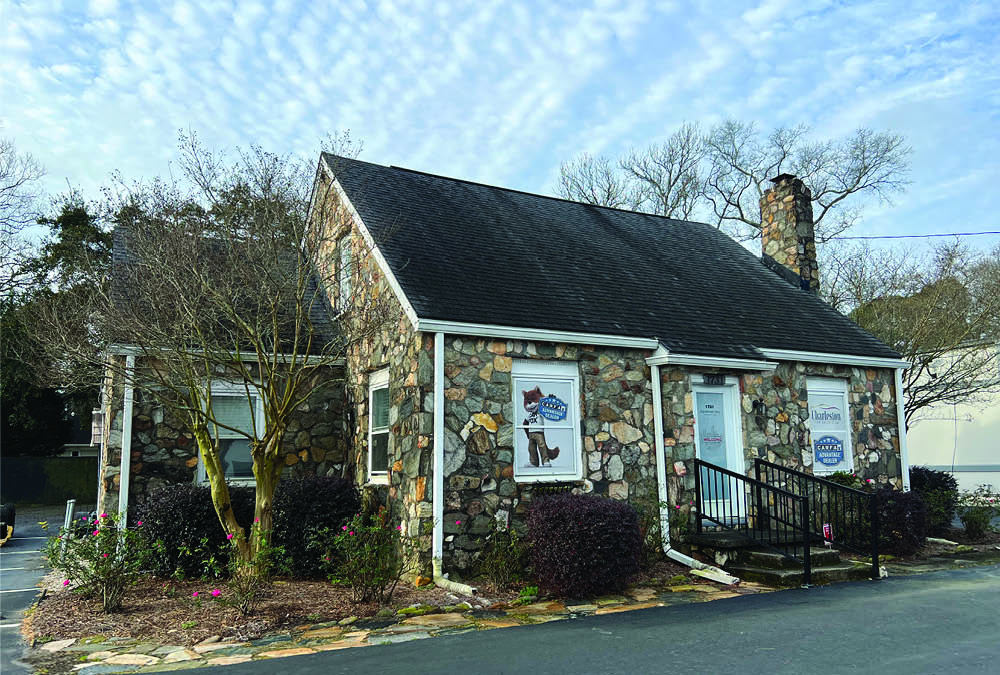Great-granddaughter of the builder of Savannah Highway’s historic “Stone House” honors her Appalachian roots through music
by Bertha Booker | Contributing Writer
Local musician Lane Gregory’s small Avondale cottage is built in what she likes to call the “Lowcountry Appalachian” style. With its moss green board-and-batten siding and shower surround made of river stones, the house has a definite mountain vibe.
Lane is one of a handful of Charleston musicians who perform “Old Time” Appalachian music (precursor of bluegrass). When Lane is not singing and playing with her Cane Creek String Band or heading to the mountains for a fiddle festival, she and other old time musicians on banjo, fiddle, mandolin, guitar, and stand-up bass often convene for foot-stomping jams in her living room, striking up 19th century favorites like “Granny Will Your Dog Bite?” and “Pretty Little Shoes.” All who visit her agree, the vaulted ceiling and loft of her mountain-inspired cottage somehow combine to create the best acoustics in town.
On Tuesday, Feb. 7, Lane texted her Cane Creek band members, “Good news! They are not demolishing my great-grandfather’s home he built!” Her text linked to a WCBD news segment titled, “Plan to Demolish Historic West Ashley House Denied.” The story reported how some West Ashley neighbors had been fighting to save a unique late-1930s stone house at 1731 Savannah Hwy. (used in recent years for commercial purposes) from being levelled.
Lane’s friends know she is very proud of her Appalachian heritage and had many relatives in the Hendersonville, N.C. area, tracing her ancestry back to an Irish man who had immigrated through the port of Charleston before settling on Cane Creek located north of Charleston between Mt. Pleasant and Georgetown. But they knew little about her family’s more recent ties to Charleston. Who was Lane’s great-grandfather and why had he built a house of stone in the Lowcountry?
In the late 1930s, Otto (“Ott”) Anders, a building contractor from Hendersonville, teamed up with his new son-in-law, Randolph Tucker Harrison Jr., to begin construction of the Stono Park neighborhood on the Harrison farm. Ander’s daughter Opal, the eldest of nine children, had met her future husband in Hendersonville where the Harrison family summered, and married in 1939. Anders moved his wife, Pearl, and the remaining eight children from Hendersonville to Charleston. Anders also loaded up a boxcar with Hendersonville stone and sent it down the mountain. He then constructed what are believed to have been the first two homes in Stono Park here in West Ashley, then called St. Andrew’s Parish. The second stone house next door, where Anders and his family lived, was demolished in 2004.
Today, the surviving stone house sits in a commercial zone at the far end of a string of car dealerships known as the Savannah Highway Auto Mile. The structure reminds the observant passer-by that suburban homes and lawns — not asphalt — once dominated this stretch of roadside.
Proponents of its demolition argued that while losing interesting structures would be unfortunate, land use continues to evolve and this building no longer fits the character of the area or serves a useful purpose.
Opponents of demolition, including West Ashley historian, author, and longtime West Of Free Press columnist Donna Jacobs, argue that as West Ashley residents become increasingly interested in preserving their suburban history, more “modern historic” buildings with ties to people and place deserve to be saved. Notably, it was the demolition of the former Anders home in 2004 that led to new regulations requiring review of all demolition requests for structures more than 50 years old in West Ashley’s commercial corridors.
Recent reporting on the remaining stone house has focused on the Harrison family and on Anders’ daughter Opal, who lived to be 103 and after whom Opal Avenue in Stono Park is named. Anders’ wife Pearl is also memorialized in Stono Park in the name of Pearlott Street.
Much less is known about the other Anders children, but they were were said to be a vivacious bunch and Gregory says the stories about them are endless. A few examples illustrate their fun-filled adaptation to Lowcountry life: there were so many girls in the family they created their own basketball team; Bobbie was a scratch golfer and pilot who delighted in flying low over the Cooper River Bridge; Jean once won the crown of Miss Charleston.
But it’s the story about Bobbie and her identical twin, June, which tops them all. A man named Mr. Taylor liked Anders’ two stone houses so much that he contracted with him to have one built for himself on James Island. Playing matchmaker, the two men arranged for Bobbie and Mr. Taylor’s son, James, to go out on a date. But as Bobbie had a golf match, she and June secretly switched places, figuring James would never know the difference. June and James ended up falling in love and June finally had to confess the crime.
“That is the story of how my grandparents met, and it was all because both of my great-grandfathers liked stone houses,” says Lane.
Anders and some of the his children eventually returned to Hendersonville, where her was killed in a car crash in 1949.
The multitude of Anders’ descendants have been avidly following news of the lone remaining stone house’s fate on Facebook, sharing old (and often conflicting) family stories about Anders and his stone houses, speaking of their ties to this unusual structure and their hopes that “Pappy’s” house survives.
Unfortunately, the stories don’t offer clarity about exactly why Anders built stone houses in the Lowcountry in the first place. One cousin writes that according to what Granny always told her, “The reason for calling it Stono Park was because all the homes were going to be stone from up here in the mountains.” (Perhaps true, though the proximity of Stono Park to the Stono River does seem to offer a competing explanation for the neighborhood’s name.)
For Gregory, the reason her great-grandfather built stone houses is simple: “I think he loved the mountains and the stones reminded him of home.”














